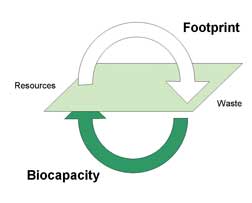|
FREE!
Holistic Health Newsletter!
Subscribe
NEW! Natural Weight Loss
Program recommended by The Share Guide
Learn More
About
Share
Guide
Holistic Health Articles
Health Directory
Reviews
Advertise
Links
Contact us
Do
you have a
Holistic
Business?
Get listed in Share
Guide's Holistic Health
Directory for only $9.95 per
month. For more info Click Here
|
With global
ecosystems degrading at an ever increasing rate, calls for sustainable
development have become more urgent. Managing for sustainability will
be impossible, however, without tools that allow us to account for our
demand on, and supply of, ecological resources.
The Ecological Footprint is an accounting tool that
makes sustainability measurable by comparing human demand on the
biosphere to the biosphere’s ability to renew itself. At the
global level, Footprint analysis finds that human society is in a state
of overshoot, with demands on ecosystems exceeding supply by over 20
percent
in 2002. The picture becomes more varied at the level of nations.
Approximately 4.5 global acres of biologically productive land are
available for each person worldwide.
Currently, the Ecological Footprint ranges from 26
global acres per person to less than 1 global acre per person. Human
livelihood and well-being will always depend closely on the health and
functioning of the natural world. No society would be able to
function without the support of healthy forests, clean waters, fertile
soils, and other types of ecological capital that provide resources for
our use and absorb the wastes that we generate. Despite these
close ties, the link between a healthy environment and a thriving
society is often overlooked, and signs of environmental overuse and
degradation are all around us. Collapsing fisheries, loss of
forest cover, and continued accumulation of wastes and pollutants are
just a few noticeable examples. In a world of increasing
standards of living and growing populations, the challenge for the 21st
century will be answering the question: how can we live well within the
means of one planet?
To even begin to answer this question, we need to be
able to take stock of what our planet can provide, and how much of it
we use. To do this, we need tools that allow us to track flows of
ecological goods and services through ecosystems and the human economy,
just as we currently track financial flows through markets. One
such accounting tool is the Ecological Footprint.
The Ecological Footprint is a very simple
concept. A Footprint adds up all of the biologically productive
land and sea area that is needed to support a population or an
individual in a given year. This provides a measure of total
ecological demand. A population’s Footprint can then be compared
to the total amount of biologically productive land on Earth (the
ecological supply) that is available to support that population.
The Footprint relies on a few fundamental principles
about the way that human and planetary systems function: Resources come
from nature, and eventually return to the biosphere as waste. Materials
don’t disappear, so we can track them through this whole process of
extraction, production, consumption, and eventually waste disposal. The
diagram above illustrates a simple path of material flow on the
Earth. Amazingly, the planet makes resources on its own (and free
of charge!) which are available for our use. After use, these
resources are converted into waste and deposited again into the
biosphere. With no intervention from humans, the biosphere can then
take this waste and convert it back to resources--again, on its own and
free of charge.
So to begin, how much nature, or biocapacity, is
actually available? The Earth itself has over 130 billion acres
of surface area. This is quite a lot of space, considering that
one acre is over 40,000 square feet. Two-thirds of this area,
however, is low productivity ocean. Another 11% is covered by
barren land, glaciers, and ice caps. Just 18 percent of the
surface area
of the Earth is productive land, and 4 percent is productive sea, meaning
that
just about 22 percent of the surface of the Earth
is actually available to
provide useful goods and services to human society.
This leaves approximately 28 billion acres of
biologically productive land on Earth. This space is shared by
just over 6.4 billion humans. Thus, simple division suggests that
there are about 4.5 global acres of biologically productive land
available for each person currently alive on Earth. This 4.5 global
acre figure assumes that all biologically productive land on Earth is
fully appropriated for human uses. There are, however, other species
here too. How much of those 4.5 global acres per person should be set
aside for other species? The prominent Harvard ecologist E.O. Wilson
suggests that we should preserve up to 50 percent of the biosphere to protect
biodiversity.
Excerpted from material provided by the Global Footprint
Network, based
in Oakland, CA. For more information, call (510) 839-8879 or visit
their website at www.globalfootprint.org
 MORE
ARTICLES MORE
ARTICLES
FREE!
If
you liked this article,
you'll love The Share Guide's
Holistic Health
Newsletter. Subscribe
for free!
Home  Health Directory Health Directory  Articles Index Articles Index  Interviews Index Interviews Index
Shop  Links Links  About Share Guide About Share Guide  Contact us Contact us
|

